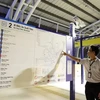New models for higher education that could change the face of universities in the future were discussed at a two-day Global Education Dialogue 2013 in Ho Chi Minh City, which ended on November 27.
Saad Rizvi, Executive Director at Pearson, and co-author of the recently published The Avalanche is Coming, categorised higher education models into five groups: the elite university; the mass university; the niche university; the local university; and the lifelong learning mechanism.
While elite universities attract the lion's share of prestigious research grants and the world's most talented students, mass universities provide education for the rapidly growing middle class, taking advantage of globally developed content, he said.
According to Sam Jones, Head of University Alliance's Communications and Public Relations, higher education systems around the world need to be thinking about how to adapt to the rapid pace of change as individuals and economies place new and changing demands on how and what it delivers.
He cited a two-year project, University Vision, implemented at his university that could be beneficial in Vietnam and ASEAN countries. As they integrate more and more, ASEAN member nations should consider future scenarios and models, he said.
The aim of University Vision was to use scenario planning to explore future issues and challenges.
To understand the future environment, they studied the major drivers of change that could affect universities.
Speakers at the conference emphasised the worldwide need for improved collaboration, governance and institutional management among higher education institutions.
The dialogue was organised by the British Council in co-operation with the Ministry of Education and Training and UK's Aston University.-VNA
Saad Rizvi, Executive Director at Pearson, and co-author of the recently published The Avalanche is Coming, categorised higher education models into five groups: the elite university; the mass university; the niche university; the local university; and the lifelong learning mechanism.
While elite universities attract the lion's share of prestigious research grants and the world's most talented students, mass universities provide education for the rapidly growing middle class, taking advantage of globally developed content, he said.
According to Sam Jones, Head of University Alliance's Communications and Public Relations, higher education systems around the world need to be thinking about how to adapt to the rapid pace of change as individuals and economies place new and changing demands on how and what it delivers.
He cited a two-year project, University Vision, implemented at his university that could be beneficial in Vietnam and ASEAN countries. As they integrate more and more, ASEAN member nations should consider future scenarios and models, he said.
The aim of University Vision was to use scenario planning to explore future issues and challenges.
To understand the future environment, they studied the major drivers of change that could affect universities.
Speakers at the conference emphasised the worldwide need for improved collaboration, governance and institutional management among higher education institutions.
The dialogue was organised by the British Council in co-operation with the Ministry of Education and Training and UK's Aston University.-VNA



















